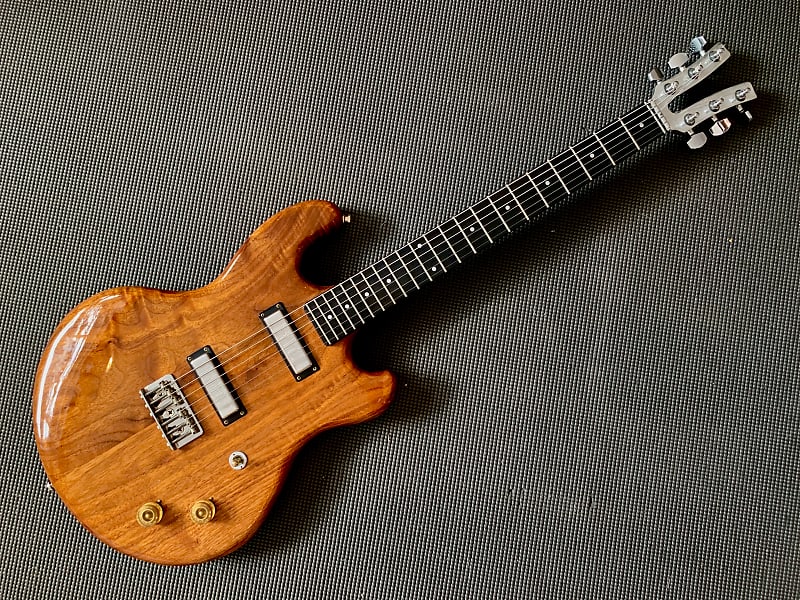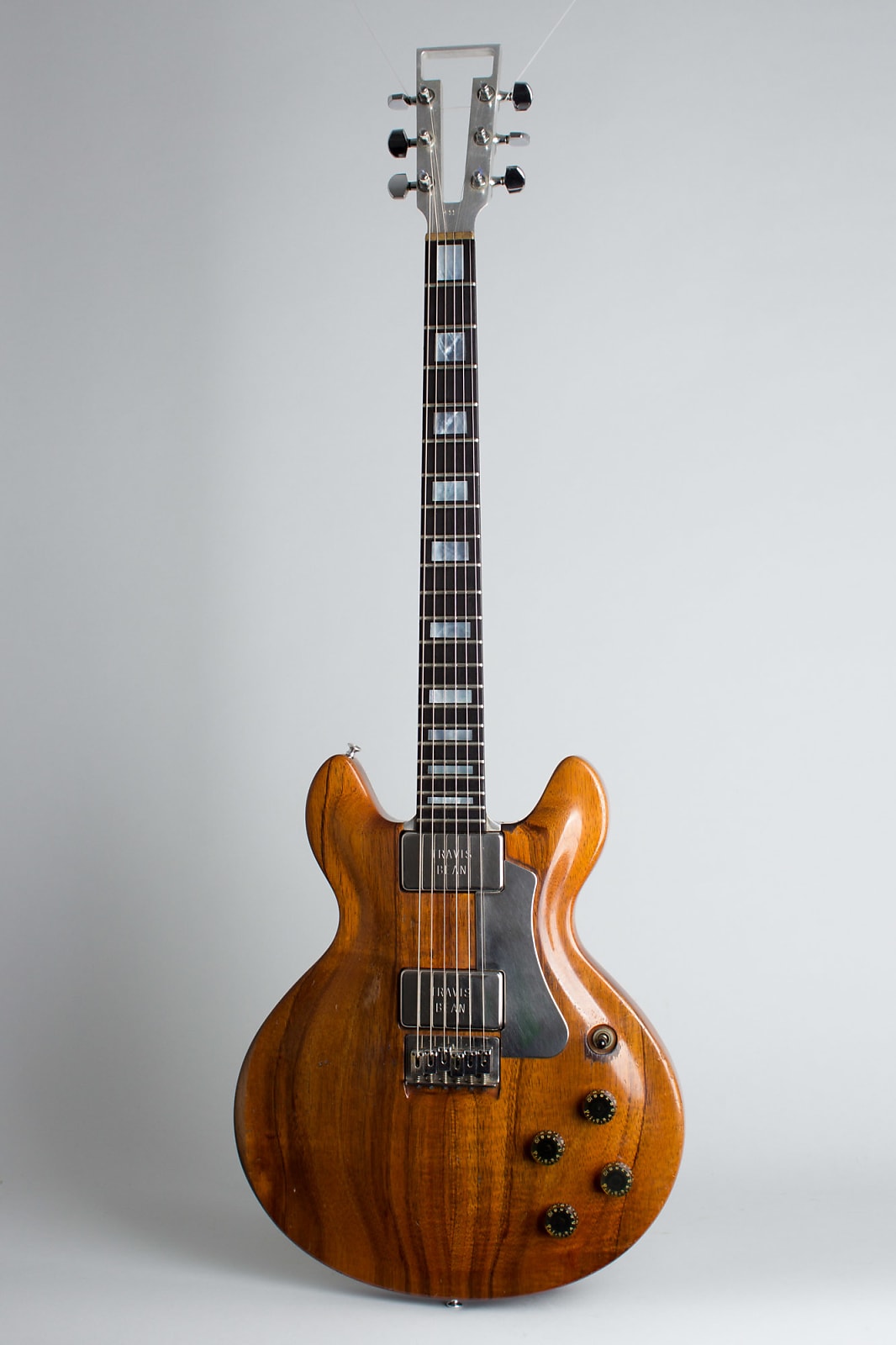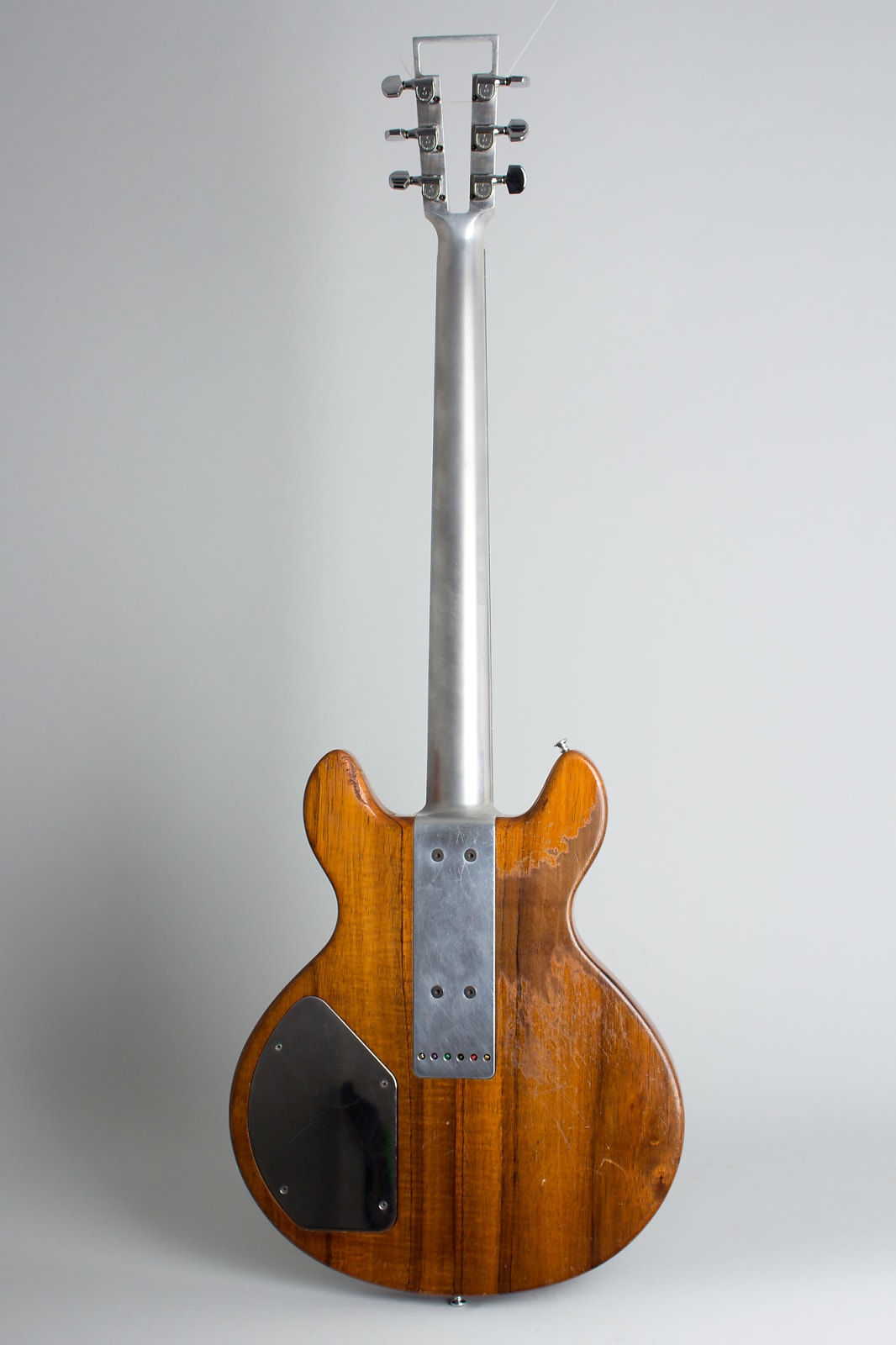California in the '70s was a hotbed of guitar invention and innovation. You only had to look up north, in the Bay Area, where Alembic was exploring active electronics, brass hardware, exotic woods, and more. Meanwhile, down south near Los Angeles, Travis Bean was interested in the potential for aluminum through-necks.
Clifford Travis Bean was born in San Fernando. He worked various jobs as he grew up, he liked to race motorcycles for extra money, and his love of art settled on metal sculpting. Music became a passion, too, and in the early '70s Travis started playing guitar and working at a music store in Burbank. It was there he met the store's guitar repairman, Marc McElwee. Travis listened and learned as the two became friends—he made a mental note that wooden necks were the cause of much repair and setup work—and soon he began building an electric guitar with Marc's help.
"Right off," he told Don Menn for Guitar Player magazine in 1979, "I thought of building the neck out of aluminum." He had no particular reason for that choice other than practicality. "It was based on my non-experience with guitars and my ignorance of old wives' tales that would have made me believe a metal neck had to be wrong," Travis explained. "Quite simply, I figured the aluminum neck would solve the problems that I'd been seeing Marc having to repair all the time."
He wasn't the first to consider aluminum for electric guitar making. Some Rickenbacker lap-steels in the early '30s were made from cast aluminum, but with a rock 'n' roll accent we need to visit Italy in the late '50s and into the '60s, where Antonio Wandrè Pioli produced a series of remarkable looking guitars for brands including Wandrè, Framez, Davoli, Noble, and Orpheum.
Aside from Pioli's striking shapes were some unusual design features, including an aluminum neck section. The best version had a through-neck with a hollow semi-circular aluminum tube leading to a frame-like headstock, with the fingerboard screwed on and a rear plastic cover providing a smooth feel.
John Veleno went further still with his guitars, making them almost entirely from hollow aluminum, with cast necks and hand-carved bodies. Based in Florida, Veleno began making his guitars around 1970, finishing them in bright anodized colors and adding to some a V-shape headstock set with a small red jewel. He gave up in 1977 after building around 185 guitars.
Back in California in 1974, Travis Bean had been working at a car dealership in Reseda and had saved enough money to take the plunge and start Travis Bean Guitars with Marc McElwee. Gary Kramer, who had given Travis his job at the car store, would also join the team.
When Gary spoke to Eric Broadbent for Kramer Korner in 2019, he recalled that one day Travis came to work at the dealership with an aluminum-neck guitar, which Gary remembered looked "like a Smith & Wesson chrome barrel with a nice wood handle—that's what I thought, because I wasn't into guitars at all." He described his role at the new firm as helping to finance the operation and "to make sure we got the sales going."
The Travis Bean company was based in Sun Valley and at first offered two humbucker-equipped guitar models—the TB1000 Standard (flat-top body, dot inlays; listing on introduction at $595) and TB1000 Artist (carved-top body, block inlays; $895)—plus the TB2000 Bass ($655). A little later came the TB3000 Wedge Guitar ($1,295) and TB4000 Wedge Bass ($1,095) with their unusual closed-Flying-V shape, and in 1977 the cheaper TB500 ($500) with single-coils.
The key factor that set the new Travis Bean instruments apart was their metal through-neck. The firm's 1975 catalogue laid out the arguments in favor of this feature, suggesting that regular wooden construction resulted in poor conductivity of vibration and that traditional methods to mount pickups isolated them from the body.
Bean's solution was what the brochure called a "neck and receiver assembly." This was a one-piece machined billet of aluminum alloy comprising headstock, neck, and an extension about half way into the body on to which the bridge and pickups were directly mounted, forming "a solid metal link" between both ends of the string, "allowing it to vibrate absolutely as long as physics will allow."
Not that aluminum alone solved the problem they identified. One of the firm's ads at the time admitted that solid aluminum "robs vibration due to its mass," so the team "hollowed out the base of the neck assembly and tapered it to form just a chassis for the length of the string."
The neck assembly would slide into a double-cutaway body that, to begin with, was made from any of a number of different woods, including teak and padauk, but very soon the Bean team settled primarily on koa—although some models used magnolia, marking a rare appearance for that timber in electric guitars.
Some players began to pick up on the sustain and bright, clear tone that this construction could offer, and early adopters included Jerry Garcia and Joe Perry, with Bill Wyman heading the list of bass fans. Others were put off by the idiosyncratic nature of the Beans, or their relatively heavy weight, or the cold feel of aluminum. There was also a tendency for aluminum and wood to expand or contract differently with changes in temperature and humidity.
Travis acknowledged the criticisms that an aluminum neck would never feel like traditional wood, although as he pointed out in 1979 to Guitar Player: "Unless you've got a totally worn-out Telecaster, you've never felt wood in your life—you've been feeling the finish."
He said that wear and scratches to an aluminum neck could be buffed out in minutes. "Nevertheless, we decided to create a more orthodox-feeling surface for those who wanted one. We now offer a choice of an uncoated neck or one painted with DuPont Imron [polyurethane]—the same thing they paint airplanes with."
Meanwhile, Gary Kramer left Travis Bean Guitars in 1975 and set up Kramer Guitars over in Neptune, New Jersey, with Dennis Berardi, Pete LaPlaca, Phil Petillo, and Henry Vaccaro. The company's early instruments were based on the aluminum-neck idea but with some changes intended as improvements.

Kramer's debut instruments were two guitar models, the 350G (listing on introduction at $425) and 450G ($545), and two basses, 350B ($465) and 450B ($595), launched in 1976. They had wooden inserts laid into the rear of the bolt-on aluminum neck—from the back, it looked like a metal bar in a wooden neck—designed to overcome the criticisms of weight and cold-feeling metal, while the headstock simplified the Travis "T" to result in a tuning-fork shape.
More Kramer models followed, including the cheaper 250 guitar and bass and higher-end 650G and 650B, the DiMarzio-loaded DMZ series, the pointy XL and XK models, and the mini-body headless Dukes.
By the early '80s, Kramer was offering conventional wooden necks as an option, and by 1985 the aluminum-neck models had all gone. Gary Kramer did not stay long at the company. But with connections to Ed Van Halen and an emphasis on superstrat designs, Kramer would become the biggest-selling electric guitar brand in the US in the mid '80s—although it would burn out and barely survive into the following decade. A revival of Kramer-style aluminum-neck guitars by Henry Vaccaro and Phil Petillo, at first with the Kramer name and then Vaccaro, lasted from the mid '90s until 2002.
Meanwhile, back in California, the Travis Bean factory was closed at the end of 1977 and then reopened the following June, continuing until August '79 when Travis Bean Guitars closed for good. Bill Kaman II reported total production figures in a 1995 piece for Vintage Guitar magazine, logging 755 TB1000 Artists, 1,422 TB1000 Standards, 1,023 TB2000 Basses, 45 TB3000 Wedge Guitars, 36 TB4000 Wedge Basses, and 351 TB500s, plus two double-necks and six five-string guitars (two of which went to Keith Richards).
Travis reappeared briefly with some new instruments in the late '90s and a plan for a new operation, Travis Bean Limited. Travis died in 2011, but today Kevin Burkett has refined the original ideas for a line of aluminum-neck guitars and basses for Travis Bean Designs at the Electrical Guitar Company, based in Irondale, Alabama.
Back in 1979, Travis Bean talked about all the new qualities of his instruments with evident pride. Maybe he knew that his original firm would soon fall apart, but whatever his private feelings at the time, he was careful to place his achievements in the context of guitar history.
"I did not intend my guitar to be a replacement for anything," he told Don Menn, "especially the old standbys and legendary names. After all, my guitar was built out of a love for past instruments. There's really no such thing as a bad guitar. I've just tried to make mine unique unto itself."
About the Author: Tony Bacon writes about musical instruments, musicians, and music. His books include Electric Guitars: Design & Invention and Legendary Guitars: An Illustrated Guide. Tony lives in Bristol, England. More info at tonybacon.co.uk.



